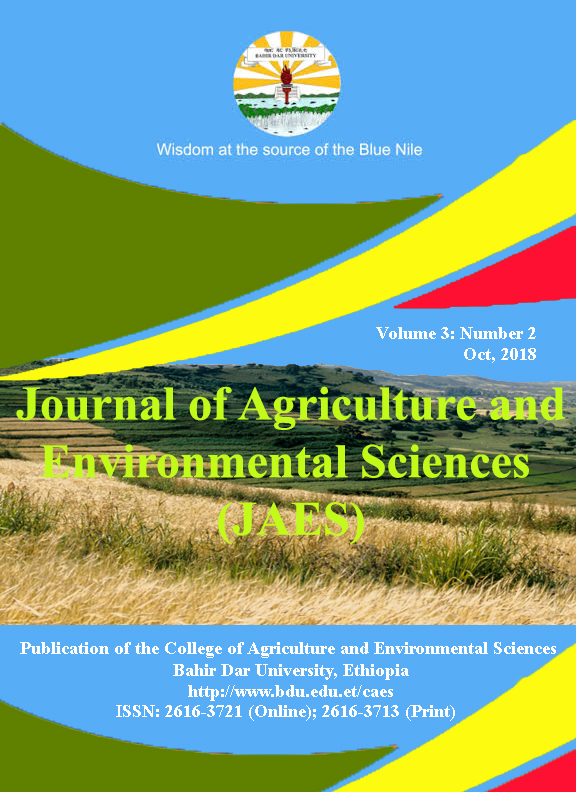Effects of Soil and Water Conservation Practices on Selected Bio-physical, and Livelihood Attributes and Farmer`s Perception at Akusti Micro Watershed, Northwest Ethiopia
Abstract
Soil and Water conservation practices are widely practiced in Akusti Micro Watershed (AMW).The main purpose of this study was to assess the effects of soil and water conservation practices (SWCP) on selected biophysical, livelihood attributes and farmer`s perception at AMW, Northwestern Ethiopia. Field survey using questioner was conducted to assess the perceptions of farmers about SWCP. Data was also collected through key informant interviews, focus group discussions, field observations and field measurements and using Google Earth with 30 meter resolution. Data was analyzed using qualitative and quantitative analytical methods using SPSS software. Yield increments were evaluated by using the quadrant measurement 1m×1m (1m²) method. Yields before construction of SWCP were assessed using questioners. The results indicated that about 168.5 hectares of land were covered by vegetation and crop yields were increased, although the increments differed from farmer to farmer as the soil management practices differed. According to the respondents, the productivities of teff, wheat, maize and potato before construction of SWCP were 460 kg/ha, 240 kg/ha, 400kg/ha and 500kg/ha, respectively. After construction of soil and water conservation measures, yields of teff, wheat, maize and potato increased up to 6800, 3500, 12000 and 16000 kg/ha, respectively. According to survey results, 84.2% of the respondents practiced land restoration activities while the remaining 15.8% were not. Farmers who perceived SWCP more effective in controlling soil erosion and ensuring sustainability of crop yields adopted modern conservation methods. In Akusti micro watershed, lands are sloppy and thus soil erosion is very high that removes all the top fertile soils, applied fertilizers and sown seeds. Cultivating these vulnerable lands without proper management may result no or very low harvest. Therefore, it is recommended to integrate the use of agricultural inputs with Swept increase crop yields.References
Alemayehu, B. (2015). GIS and remote sensing based land use/land cover change detection and prediction in Fagita Lekoma Woreda, Awi Zone, and Northwestern Ethiopia
Assefa, F. (2009). Assessment of adoption behavior of soil and water conservation practices in the Koga watershed, Highlands of Ethiopia
Ayalew, A. (2011).Construction of soil conservation structures for improvement of crops and soil productivity in the Southern Ethiopia. Journal of Environment and Earth Science 1 :2224-3216
Ayalew, G. (2014). A geographic information system based soil loss and sediment estimation in Gerdi watershed, highlands of Ethiopia
Berhanu, G. (2004).Economic incentives for soil conservation in the East African countries, 13th International soil conservation organization conference-Brisbane; paper No1026 International Livestock Research Institute (ILRI)Addis Ababa ,Ethiopia.
Chizana, C., Mapfumo, P., Albrechi, A., Vanwuk, M. and Giller, K. (2006). Smallholder farmers’ perception on land degradation and soil erosion in Zimbabwe: African crop science conference proceedings Vol.8.pp.1484-1490.
Cochran, W. G. (1977). Sampling techniques 3rd ed., John Wiley and Sons. New York, pp.428.
Demelash, M.(2010). Assessment of integrated soil and water conservation measures on key soil properties in South Gonder, North-Western Highlands of Ethiopia. Vol. 1(7), pp. 164-176, http://.org/JSSEM ISSN 2141-2391
Ermias, A. (2014). The challenges and prospects of land restoration practice the case of Misirak Badawacho Woreda of Hadiya Zone, SNNPR, Ethiopia. Belay Kassa and Million Taddesse
Kassa, B., Tadesse, M. (2004). Factors influencing adoption of soil conservation measures in southern Ethiopia: The case of Gununo Area. Journal of Agriculture and Rural Development in the Tropics and Subtropics. 105(1): 49-62
Kibemo, D.(2011).Farmer’s perception on soil erosion and their use of structural soil conservation on measures in soro district, southern Ethiopia; [MA Thesis]; Addis Ababa University, Ethiopia.
IJEM (International Journal of Environmental Monitoring and Analysis). (2013). Information needs, and knowledge gaps. Environmental economics policy forum1 (4):1-2
Tadesse, D. (2014). Impacts and impediments of community participation on soil & water conservation to sustainable land resource management in Laelay Maychew wereda, Tigray, Ethiopia.
Tesfaye, E. (2008). Continued use of soil and water conservation practices: A Case study in Tulla District, Ethiopia. M.Sc. Thesis, Wageningen University, Netherlands
Teklewold, H., Kohlin, G. (2011). Risk preferences as determinants of soil conservation in Ethiopia. Soil and water conservation society, Journal of Soil and Water Conservation 66 (2):87-96
Tesfay, T. (2015). Soil and water conservation practice in Lailay May Chew Woreda, Central Tigray, Tigray Region, Ethiopia
Copyright (c) 2019 Journal of Agriculture and Environmental Sciences

This work is licensed under a Creative Commons Attribution-NonCommercial 4.0 International License.
Authors who publish with this journal agree to the following terms:
- Authors retain copyright and grant the journal right of first publication with the work simultaneously licensed under a Creative Commons Attribution License that allows others to share the work with an acknowledgement of the work's authorship and initial publication in this journal.
- Authors are able to enter into separate, additional contractual arrangements for the non-exclusive distribution of the journal's published version of the work (e.g., post it to an institutional repository or publish it in a book), with an acknowledgement of its initial publication in this journal.
Authors are permitted and encouraged to post their work online (e.g., in institutional repositories or on their website) prior to and during the submission process, as it can lead to productive exchanges, as well as earlier and greater citation of published work (See The Effect of Open Access).


